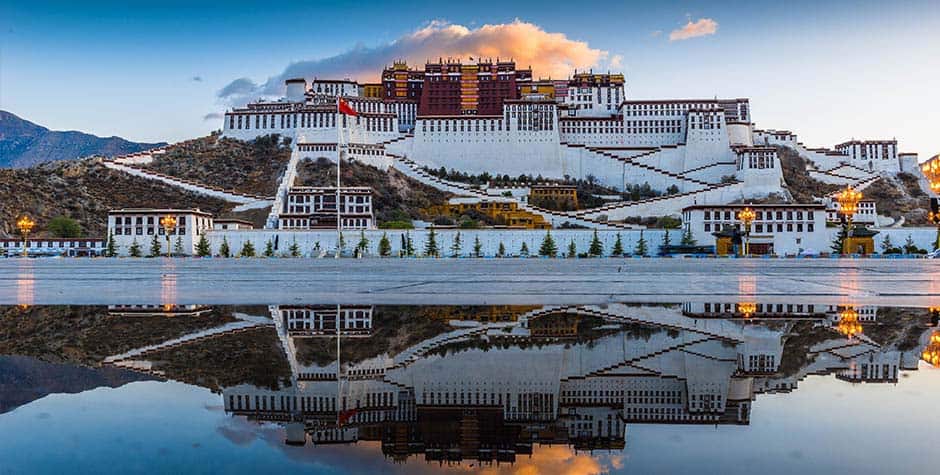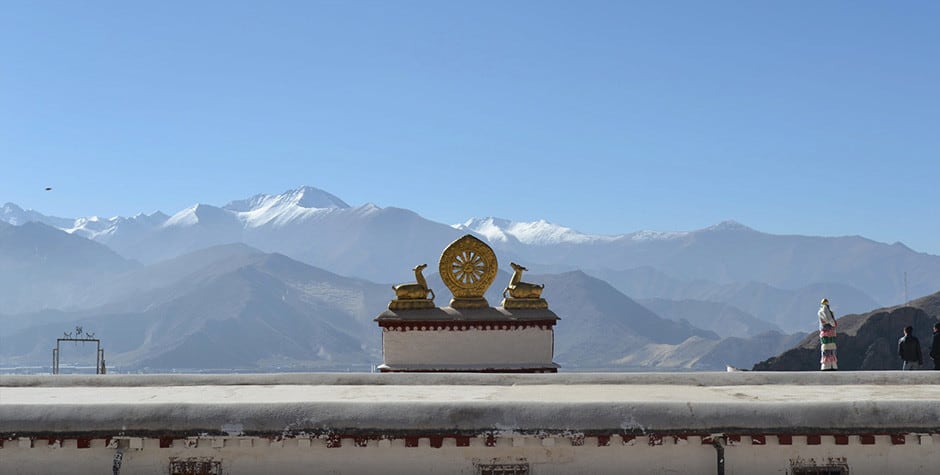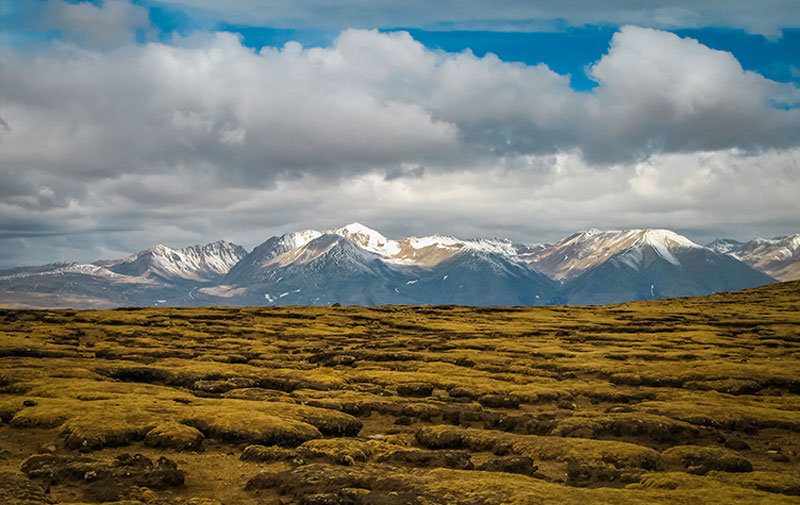Nestled amidst the mystical landscapes of Tibet, the Potala Palace stands as a testament to the rich history and culture of this enigmatic region. This magnificent architectural marvel, perched on the Marpo Ri hill, has been a symbol of Tibetan heritage for centuries. It’s more than just a physical structure; it’s a repository of Tibet’s soul and history, an embodiment of the enduring spirit of a people who have thrived in one of the world’s highest and most challenging environments.
As you embark on this journey through the corridors of the Potala Palace, you’ll discover that it’s not just a place; it’s a living, breathing chapter in the epic tale of Tibet. It’s a place where time seems to stand still, where ancient traditions and spirituality intertwine with the breathtaking architecture to create an aura that’s both serene and awe-inspiring.
In this article, we invite you to join us on a virtual expedition to the Potala Palace. We’ll uncover its history, delve into its architectural wonders, and unravel the profound cultural significance it holds for Tibetans and the world. So, fasten your seatbelts as we navigate through the heart of Tibet’s crown jewel.

The Potala Palace: A Glimpse from Afar
When you first set foot in Lhasa, Tibet, the Potala Palace is the first sight that welcomes you. It stands as a silent sentinel, a timeless witness to the ebb and flow of history in this mystical land. Its towering presence above the city is an instant reminder that you are in a place of profound cultural and historical significance.
As you disembark from your journey, perhaps arriving at the Lhasa train station, you'll find yourself crossing a bridge. It's a bridge that connects more than just two banks of a river; it connects the past to the present, the spiritual to the earthly. And as you traverse this bridge, the palace starts to reveal itself, peeking out from behind a small hill.
It's a moment of pure magic. The first glimpse of the Potala Palace is like a page torn from an ancient legend, where history meets the modern world. The palace seems to rise from the very soul of Tibet, a testament to the enduring spirit of its people.
The feeling is palpable—a mixture of excitement and reverence. You can't help but be awed by the sheer grandeur of the palace as it looms larger with each step. The intricate details, the countless windows that seem to whisper secrets of the past, and the magnificent crimson walls that bear witness to countless generations—it's all there, awaiting your exploration.
This initial encounter with the Potala Palace leaves an indelible impression on your mind. It's a moment where time seems to slow down, where the bustling world around you recedes, and you find yourself standing in the shadow of a living masterpiece. It's a glimpse from afar, but it's a glimpse into a world of wonder and reverence that you're about to uncover as you step closer to the heart of Tibet's history and culture.
History of Potala
The history of the Potala Palace is a tapestry woven with threads of spirituality, royalty, and unwavering devotion. It all began when King Songtsen Gampo, the unifier of Tibetan tribes, established the palace surrounding his meditation cave in the 7th century. This location, once at the western edge of Lhasa, became the central pillar of Tibetan culture and governance.
The story begins with King Songtsen Gampo, a visionary leader whose reign marked a pivotal moment in Tibet's history. His devotion to Buddhism led to the construction of the Potala Palace, which initially served as a retreat for his meditation and spiritual pursuits. The site was chosen carefully, situated between the prominent monasteries of Drepung and Sera and the ancient city of Lhasa. This strategic location would later become the epicenter of Tibetan civilization.
The name "Potala" itself carries profound significance. Some believe it derives from the Tibetan title for Avalokiteshvara's Pure Land, named "Potala," symbolizing the spiritual connection between the palace and the Bodhisattva of compassion, Avalokiteshvara. In essence, King Songtsen Gampo's choice of location was a spiritual one, aligning the palace with the essence of Tibetan spirituality.
In the 17th century, the palace underwent a transformative phase when the fifth Dalai Lama made it the winter residence of the Dalai Lamas and the seat of the Gelugpa sect, effectively centralizing religious and political power. This marked a shift in the palace's purpose, evolving from a royal retreat to a symbol of Tibetan governance and spirituality.
The palace's construction is a testament to the architectural prowess of its time. Its sturdy stone walls, some as thick as 8 meters, and soaring structure with over a thousand rooms and approximately 10,000 shrines and 200,000 statues demonstrate the grandeur and complexity of this masterpiece.
The Potala Palace isn't merely a building; it's a living chronicle of Tibetan history, an enduring symbol of the nation's unwavering connection to its roots. Each stone, each mural, and each prayer wheel bears witness to the passage of time and the evolution of Tibet, from the days of King Songtsen Gampo to the contemporary era.
As we unveil the history of the Potala Palace, we uncover not just a magnificent structure but a narrative that resonates with the very soul of Tibet. It's a journey through time, a testament to the resilience and spirituality that define this remarkable land and its people.
Architectural Marvel: Constructing the Potala Palace
The Potala Palace is not merely a structure; it is a breathtaking masterpiece of Tibetan architecture. It stands as a testament to the ingenuity and craftsmanship of Tibetan builders, who designed and constructed this architectural marvel to withstand the fierce winds and high altitudes of the Tibetan Plateau.
The very first thing that strikes you about the Potala Palace is its sheer grandeur. Its towering presence above Lhasa commands attention, and its architectural intricacies draw you in. But what truly sets it apart is its construction, which was nothing short of a feat of engineering and design excellence.
The most notable feature of the palace's construction is its ability to endure the extreme climate and environmental conditions of Tibet. Situated at an altitude of 3,700 meters, the Potala Palace faces not only the challenges of a high altitude but also the harsh Himalayan winds. The architects and builders, with their deep understanding of the region, ensured that the palace was not just a beautiful structure but one that could stand the test of time.
The walls of the Potala Palace are a marvel in themselves, averaging three meters in thickness. These thick walls provide not only insulation against the biting cold of Tibet but also structural stability against the region's seismic activity. In addition to their practicality, the walls are a reflection of the palace's endurance and permanence, standing tall for centuries as a symbol of Tibetan heritage.
The straw-stick design on the top of the palace is a fascinating element of its architecture. It's more than just an aesthetic choice; it serves a functional purpose. This unique design, made of straw and sticks, is both lightweight and wind-resistant. It's as if the palace has been tailored to withstand the powerful gusts that sweep across the Tibetan Plateau. The straw-stick design adds an element of aerodynamic efficiency to the palace, a feature that's perhaps unique in the world of architecture.
The palace's construction is a testament to the resourcefulness of its builders. They adapted to the harsh conditions of Tibet, using the limited resources available to create a structure that combines elegance and endurance. It's a true representation of Tibetan culture and spirit, where every element has a purpose and where beauty and functionality go hand in hand.
As you explore the Potala Palace, take a moment to admire the architectural genius that went into its creation. The palace is more than a building; it's a living example of human resilience and creativity in the face of some of the world's most challenging conditions. It's a testament to the skill and dedication of Tibetan builders, who have left a legacy that continues to awe and inspire visitors from around the world.
The Spiritual Connection
The name "Potala" is not just a title for a grand palace; it's deeply ingrained in the spiritual tapestry of Tibetan beliefs. It finds its roots in the legendary abode of Avalokitesvara, the Lord of Compassion, and for Tibetans, this connection runs deep. It's a bridge between the earthly and the divine, a testament to the intertwining of faith and heritage.
Avalokitesvara, also known as Chenrezi, is a central figure in Tibetan Buddhism, representing compassion and mercy. Tibetans believe that Avalokitesvara watches over and protects the land and its people, embodying the very essence of Tibetan spirituality. The connection between Avalokitesvara and Tibet is so profound that many believe that King Songtsen Gampo, the visionary unifier of Tibetan tribes, was a manifestation of the Lord himself.
The Potala Palace, bearing the name of Avalokitesvara's sacred abode, symbolizes this spiritual connection. It's not just a building; it's a conduit for divine energy and a testament to the faith that courses through the veins of Tibet. It's a place where earthly and spiritual realms meet, where history and spirituality converge.
Throughout the ages, the Potala Palace has served not only as a physical residence but as a spiritual one. It's where Tibetan rulers found not just shelter but a deep connection to their spiritual roots. The palace became a place of meditation and reflection, where leaders could seek guidance and inspiration from the spiritual legacy of Tibet. It's a place where the secular and the sacred found common ground, shaping the history and culture of this unique land.
As you wander through the halls and chambers of the Potala Palace, remember that you are not merely exploring a historical relic; you are stepping into a place where the spiritual pulse of Tibet beats strongly. It's a reminder that this palace, perched on Marpo Ri hill, is not just an architectural marvel but a living testament to the profound connection between Tibetans and their spiritual heritage.
Sacred Artifacts Within
Stepping into the hallowed halls of the Potala Palace is like entering a treasure trove of sacred objects, art, and historical relics. It's a journey through time, where each artifact, whether a sculpture, a painting, or a scripture, holds a unique story and significance that adds depth to the rich tapestry of Tibetan culture.
One of the most striking features of the palace is the abundance of sculptures. These finely crafted statues represent not just artistic prowess but are embodiments of the spiritual and religious beliefs of Tibet. From the serene and compassionate faces of Bodhisattvas to the imposing forms of Tibetan deities, these sculptures speak of a deep-seated reverence for the divine.
As you move through the palace, you'll be captivated by the intricate paintings adorning its walls. These murals are more than just artistic expressions; they are windows into the spiritual and historical narratives of Tibet. They depict the lives of great Tibetan rulers, important events in Tibetan history, and the tales of revered Buddhist figures. Each stroke of paint, each color, and each composition tells a story that adds to the palace's cultural significance.
Scriptures, too, find their place within the sacred chambers of the Potala Palace. These ancient texts, meticulously transcribed by hand, are a testament to the importance of knowledge and wisdom in Tibetan culture. They contain the teachings of Buddhism, philosophy, and historical records that offer valuable insights into the spiritual and intellectual heritage of Tibet.
The Potala Palace is a sanctuary of sacred artifacts, each contributing to the grand narrative of Tibet. It's a place where art and spirituality converge, where history and culture intertwine. Exploring the palace is not just a visual experience; it's a spiritual journey, an opportunity to connect with the profound beliefs and traditions that have shaped Tibet for centuries.
As you encounter these artifacts, take a moment to immerse yourself in their stories. Listen to the whispers of history, the echoes of devotion, and the profound teachings of Tibet. The Potala Palace is not just a structure; it's a living repository of the soul of Tibet, and every artifact within its walls is a key to unlocking the secrets of this extraordinary land.
Visiting the Potala Palace
Before you embark on your journey to explore the Potala Palace, it's essential to understand and respect the guidelines and regulations that govern this sacred place. These rules are in place to ensure the preservation of the palace's rich heritage and the sanctity of the artifacts it houses.
One of the most important rules to remember is that eatables and drinks are not allowed within the palace. This regulation may seem strict, but it's a necessary step to safeguard the precious artifacts and artworks that grace the interior of the Potala Palace. The ban on food and beverages is an acknowledgment of the reverence Tibetans hold for this historical and spiritual site.
Another notable restriction within the palace is photography. While the urge to capture the beauty and history that surrounds you is understandable, the limitations on photography are vital for the preservation of the treasures it holds. The delicate paintings, sculptures, and scriptures that line the walls and halls are susceptible to damage from flash photography and excessive camera use. Hence, visitors are not permitted to take photographs inside the palace.
Respecting these guidelines is not just a matter of compliance; it's an expression of reverence for the cultural and spiritual significance of the Potala Palace. By adhering to these rules, you contribute to the ongoing preservation of this extraordinary heritage, ensuring that it remains a place of wonder and inspiration for generations to come.
As you prepare to explore the Potala Palace, take a moment to appreciate the importance of these regulations. They serve as a reminder that this isn't just another tourist destination; it's a living repository of Tibetan culture, history, and spirituality. Your visit is an opportunity to connect with the profound beliefs and traditions that have shaped Tibet for centuries, and by following these guidelines, you become part of the effort to protect and preserve this invaluable cultural treasure.
Rules and Regulations
The Potala Palace isn't just a tourist attraction; it's a place of profound reverence and cultural significance. To preserve its sanctity and protect its invaluable treasures, there are essential rules and regulations in place. As a visitor, it's vital to be aware of and respect these guidelines to ensure that the palace remains a place of wonder and inspiration for generations to come.
One of the primary regulations to keep in mind is the restriction on bringing food and beverages within the palace premises. While it may seem like a simple rule, it carries immense cultural weight. The ban on eatables and drinks is a testament to the deep respect Tibetans hold for this historical and spiritual site. It serves as a reminder that the Potala Palace isn't just a building; it's a living repository of Tibetan culture and history.
Another vital regulation pertains to photography within the palace. While it's natural to want to capture the beauty and history that surrounds you, there are limitations on photography to protect the delicate and priceless artifacts within the palace. Flash photography and excessive camera use can potentially damage the paintings, sculptures, and scriptures that grace the walls and halls. Thus, visitors are not allowed to take photographs inside the palace.
By adhering to these rules and regulations, you become a participant in the ongoing preservation of the Potala Palace. Your compliance ensures that the palace remains a place of cultural significance, where the rich history and spirituality of Tibet are celebrated and protected.
As you explore this remarkable site, take a moment to reflect on the importance of these regulations. They are not mere restrictions but a demonstration of respect for the profound beliefs and traditions that have shaped Tibet for centuries. Your visit to the Potala Palace is an opportunity to connect with the heart and soul of Tibet, and by observing these guidelines, you become a guardian of this extraordinary heritage.
The Journey to the Summit
Embarking on a tour of the Potala Palace is a remarkable journey, both culturally and physically. To fully appreciate the experience, it's essential to understand the logistics involved in reaching the summit of the Marpo Ri hill, where this magnificent palace stands.
The ascent to the palace is not your average walk in the park. It involves a climb of about 300 meters above the ground level. The altitude in Lhasa is significantly higher than many other places, and the dry atmosphere can take some getting used to. Therefore, it's recommended to delay your visit to the Potala Palace until you've had a chance to acclimate to the conditions. This is particularly important if you have elderly group members with you.
To make your ascent more comfortable, consider bringing a walking stick. This simple tool can provide valuable support and stability as you climb towards the palace. It's not just a practical aid; it can also serve as a symbol of your determination to explore this cultural treasure and your respect for the heritage it represents.
The journey to the summit of the Potala Palace is more than just a physical climb; it's a spiritual and cultural ascent. It's an opportunity to connect with the profound beliefs and traditions of Tibet, to stand in a place where history and spirituality converge. As you make your way up, take in the breathtaking views of Lhasa and its surrounding mountains, and let the experience resonate within you.
Visiting the Potala Palace is a pilgrimage, a symbolic journey towards a deeper understanding of Tibet's heritage. The climb to the summit is not merely a physical effort; it's a testament to your curiosity, your reverence for history, and your eagerness to explore a place that has captured the hearts and minds of countless travelers throughout the ages.
Fun Facts About the Potala Palace
Beyond its awe-inspiring beauty and rich history, the Potala Palace holds a treasure trove of intriguing facts and details that make it even more fascinating. Here are some fun facts that add depth to your appreciation of this iconic Tibetan landmark:
A Palace of Many Layers: The Potala Palace is not the result of a single construction effort. It was extended multiple times throughout its storied history. What stands today is the culmination of generations of architectural ingenuity and spiritual significance. Each expansion added new layers of meaning and beauty to this remarkable structure.
The Sweet Touch of Preservation: The paint used to maintain and restore the Potala Palace has a unique ingredient - sugar. When visitors donate white paint for the palace, it's mixed with sugar, which serves as a natural adhesive. This unusual yet effective choice of ingredient has played a significant role in preserving the palace's vibrant colors and intricate designs.
Priceless Gemstones: The Potala Palace houses a remarkable collection of precious stones, some of which are believed to be one-of-a-kind. These gemstones are often used to adorn religious artifacts, sculptures, and paintings within the palace. The presence of such rare and valuable materials adds to the palace's allure and its status as a cultural treasure.
These fun facts provide a glimpse into the intricacies of the Potala Palace and the dedication involved in its construction and preservation. As you explore this iconic landmark, keep these details in mind, and let them deepen your appreciation for the rich tapestry of history, culture, and spirituality that the palace represents.
Preserving History: UNESCO World Heritage Site
The inclusion of the Potala Palace on the UNESCO World Heritage List in 1994 was a significant milestone in the ongoing effort to preserve the rich cultural and historical heritage of Tibet. This prestigious designation is not merely an acknowledgment of the palace's architectural grandeur but a testament to its profound importance in the tapestry of human history.
The Potala Palace is not just a physical structure; it's a living repository of Tibetan culture, spirituality, and governance. Its halls echo with the wisdom of generations, its walls bear witness to centuries of devotion, and its artwork tells stories that transcend time. Recognizing its role as a custodian of such invaluable treasures, UNESCO took a decisive step to protect and celebrate this iconic landmark.
The designation as a UNESCO World Heritage Site ensures that the Potala Palace receives the recognition it deserves on a global scale. It is an invitation to the world to stand in awe of the palace's grandeur and to appreciate the spiritual and cultural significance it holds. It also emphasizes the collective responsibility to safeguard this heritage for future generations.
The inscription of the Potala Palace as a UNESCO World Heritage Site is a symbol of unity, transcending geographical boundaries and cultural differences. It is a commitment to preserving the history and culture of Tibet, a testament to the importance of understanding and respecting diverse traditions, and a reminder that some places are not just tourist attractions but living legacies of humanity's shared heritage.
As you stand before the Potala Palace, take a moment to reflect on the significance of this UNESCO recognition. It's an affirmation of the value of cultural diversity and a call to protect and cherish the extraordinary sites that connect us to our collective past.
Challenges and Restoration Efforts
The Potala Palace, as an ancient and revered structure, has not been without its share of challenges and moments of vulnerability. Its journey through time is marked not only by its grandeur but also by the trials it has endured.
During such tumultuous period, the Potala Palace suffered some damage. The echoes of unrest and the impacts of a changing world reached even this sacred sanctuary. It was a poignant reminder that historical landmarks, no matter how hallowed, are not immune to the shifting tides of history.
However, the story of the Potala Palace also includes a testament to the power of preservation and the dedication to maintaining the past for future generations. The Cultural Revolution of 1966 through the intervention of Zhou Enlai, the Premier of the People's Republic of China, it was spared from the destruction that befell many other cultural and historical relics during that time. This pivotal decision ensured the survival of the Potala Palace, Jokang Temple and many more strcture, its significance as a cultural treasure remained intact.
The challenges faced by the Potala Palace serve as a reminder of the importance of safeguarding our shared heritage. In a world marked by change and uncertainty, the preservation of cultural treasures takes on new meaning. It highlights the collective responsibility to protect and celebrate the places that carry the weight of history, spirituality, and culture.
The restoration efforts that have been ongoing stand as a beacon of hope. They are a testament to the unwavering commitment to ensuring that the Potala Palace continues to inspire awe and reverence for generations to come. As visitors, we have the privilege of witnessing not only the palace's beauty but also its resilience—a symbol of the enduring spirit of a culture that remains eternally connected to its past.
With each step we take within the palace, let us reflect on the challenges it has weathered and the restoration efforts that have preserved it. It's a reminder that history is not just a thing of the past but a living, breathing entity that continues to shape our understanding of the world.
A Soaring Symbol of Tibetan Culture
The Potala Palace is more than a physical structure; it stands as a soaring symbol of Tibetan culture, history, and spirituality. Its presence is a testament to the enduring spirit of a people and the unbroken thread that connects the past, the present, and the future.
As visitors from around the world stand before the Potala Palace, they are not merely in the presence of an architectural wonder; they are in the heart of Tibetan culture. The palace is a living embodiment of the values, beliefs, and traditions that have shaped Tibet for centuries. It is a sanctuary where spirituality, art, and governance converge in a harmonious blend.
The grandeur of the palace, with its towering structure, intricate artwork, and rich history, is a source of awe and reverence for all who have the privilege of walking its hallowed halls. It is a reminder that culture is not static but a living force that persists, adapts, and thrives through the passage of time.
The Potala Palace, with its rich history and enduring significance, serves as a bridge between the past and the present. It reminds us of the importance of understanding and respecting the cultural diversity that enriches our world. It is a symbol of the resilience of a people who have weathered storms and preserved their heritage.
Each step taken within the Potala Palace is a step back in time and a step forward into the future. It is an opportunity to witness the majesty of Tibetan culture and to be inspired by the profound spirituality that emanates from its walls.
The palace is not just a destination for travelers; it is a destination for the soul. It invites contemplation, reflection, and a deep appreciation for the beauty of a culture that has endured for generations. The Potala Palace is a soaring symbol of Tibetan culture, and it will continue to inspire and captivate the hearts of all who are fortunate enough to experience its magnificence.
Experiencing Tibet with a Local Agency
Exploring Tibet is not merely a journey; it is an immersion into a world of unparalleled beauty, rich culture, and deep spirituality. To make the most of your adventure in this enchanting land, beginning your journey with a local Tibetan travel agency is not just advisable; it's essential.
i-Tibet Travel & Tours, a renowned and trusted agency, opens the door to a unique and enriching experience in Tibet. The agency brings to the table an unparalleled understanding of the region, born from a deep connection to the land, its history, and its people.
Why is it so crucial to explore Tibet with a local agency?
The answer lies in the authenticity and depth of your journey. Tibet is not like any other destination; it is a place where every mountain, every monastery, and every prayer flag carries centuries of stories and significance. To truly grasp the essence of Tibet, you need guides who breathe the same air, walk the same paths, and hold the same reverence for the land.
I-Tibet Travel & Tours provides you with the opportunity to delve deep into the heart of Tibet, uncovering its secrets and experiencing its treasures through the eyes of those who call it home. The agency's commitment to responsible tourism ensures that your journey leaves a positive impact on both the region and its people.
As you embark on this extraordinary voyage, you will discover that Tibet is not a destination but a spiritual and cultural odyssey. Every step you take is a step back in time, a step closer to the traditions and beliefs that have defined this land for centuries.
I-Tibet Travel & Tours offers a range of meticulously crafted tour packages, catering to various interests and budgets. Whether you seek a cultural immersion, a trekking adventure, or an exploration of Tibetan history, the agency can tailor your journey to meet your specific needs.
Before embarking on your journey to Tibet, it is essential to familiarize yourself with the necessary documents, including the Tibet travel permit, ensuring a seamless and hassle-free adventure.
The Tibet Travel Planner provided by I-Tibet Travel & Tours is a valuable resource to assist you in planning your trip. It includes tips on what to pack, where to stay, and the must-visit attractions in Tibet.
For travelers new to Tibet, the "About Tibet" guide provided by the agency offers an extensive overview of the region's history, culture, and top attractions. It serves as a compass to navigate the complexities and richness of Tibet.
Your journey to Tibet is not just a physical expedition; it is a spiritual and cultural odyssey. It is an opportunity to connect with a land that has touched the souls of countless pilgrims, adventurers, and seekers. Tibet Travel & Tours, as your trusted guide, ensures that every moment of your voyage is filled with wonder, discovery, and a deep connection to the heart of Tibet.
So, as you prepare to embark on this extraordinary adventure, remember that Tibet is not just a place on the map; it is a place in the heart.
Preparing for Your Journey
Embarking on a journey to Tibet is a dream for many, but it requires careful preparation to ensure a smooth and enriching experience. The key to a successful Tibet tour lies in having the right information and necessary permits.
The Tibet Travel Permit: When planning your trip to Tibet, obtaining a Tibet travel permit is a fundamental requirement. This permit is essential for both international and domestic travelers, and it allows you to enter and travel within the Tibet Autonomous Region. The permit is not something you can obtain independently, as it must be arranged through a registered travel agency like Tibet Travel & Tours. The agency's expertise in handling the permit process ensures that your journey complies with all government regulations and that you have the necessary documentation to explore Tibet.
Tibet Travel Planner: Navigating the unique landscape and culture of Tibet can be a complex task, especially for first-time travelers. To assist you in your journey, Tibet Travel & Tours provides a comprehensive Tibet Travel Planner. This invaluable resource is designed to offer guidance and practical tips for your adventure. It includes information on what to pack, where to stay, and the must-visit attractions in Tibet. By using the Tibet Travel Planner, you can be well-prepared for your journey and make the most of your time in this extraordinary region.
Understanding the Region: Tibet is not like any other destination you may have visited. It is a land steeped in history, spirituality, and culture. The more you understand about Tibet, its traditions, and its people, the more profound your experience will be. The "About Tibet" guide provided by Tibet Travel & Tours offers an in-depth overview of the region. It explores the history, culture, and top attractions, serving as a compass to navigate the complexities and richness of Tibet. Whether you're interested in the significance of Tibetan monasteries or the stories behind ancient rituals, this guide provides valuable insights to enhance your journey.
Customizing Your Experience: I-Tibet Travel & Tours recognizes that every traveler is unique, with varying interests and preferences. As you prepare for your journey, consider customizing your experience to align with your goals. The agency offers a range of meticulously crafted tour packages, catering to cultural enthusiasts, adventure seekers, and history buffs. By selecting a tour that resonates with your interests, you can make the most of your time in Tibet and ensure that your journey is tailored to your needs.
In conclusion, preparing for your Tibet tour involves obtaining the necessary permits, equipping yourself with the right resources, and understanding the region's unique characteristics. I-Tibet Travel & Tours simplifies this process by providing the essential Tibet Travel Planner and expert guidance. With careful preparation, you can embark on a journey that not only fulfills your dreams but also leaves a lasting impression on your heart. As you set out to explore the remarkable landscapes and culture of Tibet, remember that it is a place where dreams meet reality, and every moment is an opportunity for discovery and connection.
Conclusion
In the heart of Tibet, where the Himalayas kiss the sky and the air is filled with reverence, the Potala Palace stands as a testament to the boundless depths of Tibet's rich history and culture. As we conclude our virtual journey through this remarkable destination, it becomes abundantly clear that the Potala Palace is much more than just a magnificent structure; it is a living, breathing embodiment of the essence of Tibet.
A Living Legacy: The grandeur of the Potala Palace is not limited to its towering physical presence; it extends into the very heart and soul of Tibetan history. This iconic structure is a living legacy, where each stone and beam echoes the stories of kings, monks, and people who have called it home. It's a place where the past and present coexist harmoniously, and every whisper of the wind carries with it the wisdom of centuries.
A Spiritual Sanctuary: The Potala Palace isn't merely an architectural marvel; it is a sanctuary of spirituality. It has been a place of meditation, worship, and reflection for generations of Tibetans. The aura of divinity that permeates its chambers is palpable, inviting visitors to connect with something greater than themselves. It's a space where the boundaries between the material and the spiritual blur, leaving those who tread its hallowed halls forever changed.
A Triumph of Architecture: The architectural brilliance of the Potala Palace is a testament to human ingenuity. It's a structure that defies the elements, withstanding the fierce winds and high altitudes of Tibet. From its thick stone walls to the unique straw-stick design at its apex, every aspect of its construction tells a story of determination and craftsmanship.
A Symbol of Resilience: The Potala Palace symbolizes the unwavering resilience of the Tibetan people. It has weathered changes, unrest, and the passage of time while retaining its significance. Its existence today is a testament to the resilience of a our culture.
A Connection with History: Every step within the Potala Palace is a step into the annals of history. It's a place where the past isn't relegated to books but is brought to life through art, artifacts, and the very stones of the palace. The connection between the people of Tibet and their history remains unbroken, and the Potala Palace serves as a living bridge between the two.
As we bid adieu to our virtual exploration, the Potala Palace remains etched in our hearts as a symbol of Tibetan heritage, resilience, and the enduring connection between a people and their history. For those fortunate enough to visit this sacred site, it becomes a transformative experience, a journey into the depths of spirituality, history, and culture. The Potala Palace stands as a living reminder that some destinations are not just places to visit; they are places to be profoundly touched and forever changed.
Are there guided tours available for visitors?
Exploring the Potala Palace can be a mesmerizing journey, but to truly unlock its mysteries and understand its profound history and significance, guided tours are a valuable option for visitors. Whether you're a history enthusiast, a spiritual seeker, or a curious traveler, guided tours offer a deeper insight into this magnificent UNESCO World Heritage Site.
Expert Guides: All our Tour guides that will take your to the Potala Palace are led by knowledgeable and experienced guides. These guides are well-versed in the history, culture, and spirituality that permeate every nook and cranny of the palace. Their expertise transforms your visit into a rich learning experience.
Historical Narratives: The Potala Palace is not just a structure; it's a living testament to Tibet's past. Guided tours unravel the historical narratives, taking you on a journey through the annals of time. You'll hear captivating stories of kings and monks, of the palace's construction and its role in Tibetan governance.
Spiritual Significance: For those seeking spiritual insights, the guides provide a glimpse into the palace's profound spiritual significance. They explain the rituals, ceremonies, and the deep connection between Tibetan Buddhism and the Potala Palace. It's a chance to feel the spiritual aura that surrounds the palace.
Architectural Wonders: The architectural marvels of the Potala Palace come to life through the eyes of the guides. They explain the unique construction techniques, the purpose behind the thick stone walls, and the symbolic significance of the palace's design. You'll gain a newfound appreciation for the craftsmanship that created this masterpiece.
Art and Artifacts: The palace houses a treasure trove of art and artifacts. Guided tours offer insights into the significance of sculptures, paintings, and scriptures. Each piece of art has a story, and guides provide context that enhances your understanding of Tibetan culture and history.
Ask Questions: Guided tours encourage interaction. Visitors can ask questions, seek clarifications, and engage in meaningful discussions with guides. It's an opportunity to satisfy your curiosity and delve deeper into the aspects that intrigue you.
A Deeper Connection: Perhaps the most significant advantage of guided tours is the deeper connection you establish with the Potala Palace. It's not just a visit; it's an immersive experience that leaves an indelible mark on your memory. You leave with a profound understanding of the palace's significance.
Respecting the Rules: Guided tours also ensure that visitors respect the rules and regulations of the Potala Palace. Eatables and drinks are not allowed inside, and photography is restricted. Guides make sure that visitors adhere to these guidelines, preserving the sanctity of the palace.
In conclusion, guided tours at the Potala Palace are a gateway to a richer, more meaningful experience. They allow you to connect with the palace on multiple levels—historical, cultural, spiritual, and architectural. It's an opportunity to delve into the heart of Tibet's heritage and leave with a profound appreciation for this remarkable UNESCO World Heritage Site.
What should I wear when visiting the Potala Palace?
When visiting the Potala Palace, selecting the appropriate attire is not only a matter of comfort but also a sign of respect for the palace's cultural and spiritual significance. Here are some guidelines to ensure you're dressed appropriately for your visit:
Layered Clothing: Lhasa's weather can be quite unpredictable, with temperature variations throughout the day. It's advisable to dress in layers, so you can easily adapt to changing conditions. Start with a light, breathable base layer and add on as needed. This way, you'll stay comfortable during your entire visit, whether it's the chill of the morning or the warmth of the afternoon.
Modesty is Key: When exploring the Potala Palace, it's essential to dress modestly. This means avoiding clothing that is too revealing or provocative. For both men and women, clothing should cover the shoulders and knees. For women, wearing skirts or dresses that fall below the knee is a respectful choice. Men can opt for long pants or traditional Tibetan attire.
Hats and Head Coverings: While it's essential to protect yourself from the sun, it's important to remove your hat or any head coverings when entering the palace. This gesture shows respect for the sacred space and the culture it represents.
Comfortable Footwear: Since your visit will involve a climb of about 300 meters above ground level, comfortable and supportive footwear is a must. Choose walking shoes or sneakers with good grip to make the ascent more manageable. It's best to avoid high heels or uncomfortable footwear, as you'll be on your feet for a significant part of the tour.
Sun Protection: The high altitude of Lhasa means that the sun's rays can be quite strong. Don't forget to wear sunscreen, sunglasses, and a wide-brimmed hat during your outdoor portions of the tour. This will help protect your skin and eyes from the harsh sunlight.
Carrying a Scarf or Shawl: Many visitors to the Potala Palace choose to carry a scarf or shawl with them. It serves multiple purposes—you can use it as a covering for your shoulders, a head covering if needed, or even as an extra layer if the temperature drops unexpectedly.
By following these dress code guidelines, you not only ensure your own comfort during the visit but also show respect for the cultural and spiritual importance of the Potala Palace. It's an opportunity to immerse yourself in the rich traditions and heritage of Tibet while exploring this iconic UNESCO World Heritage Site.
When is the best day to visit Potala Palace
Selecting the perfect day for your visit to the Potala Palace is a vital decision that can significantly impact your experience. Here's some valuable information to help you decide when the best day to explore this iconic site is:
The Third Day in Tibet: Many seasoned travelers and tour guides recommend visiting the Potala Palace on your third day in Tibet. By this time, your body has likely adjusted to the high altitude and thinner air, making the ascent to the palace more manageable. Acclimating to the altitude is crucial, as it can help prevent altitude sickness and ensure you enjoy your visit to the fullest.
Booking Tickets in Advance: Visiting the Potala Palace requires advance ticket booking. These tickets are typically purchased as part of a tour package through a reputable travel agency. Booking your tickets well in advance is crucial because the palace has a daily visitor limit, and spots can fill up quickly, especially during the peak tourist season.
Be Prepared for Unforeseen Situations: Travel plans can sometimes be unpredictable. Flights may be delayed or rescheduled, and unexpected events can occur. To ensure you don't miss your appointment to visit the Potala Palace, it's wise to plan for contingencies. Allow some flexibility in your schedule to accommodate unforeseen situations that may affect your travel plans.
The Ideal Timing: While visiting on the third day is a good rule of thumb, it's important to consider other factors like the time of day. The Potala Palace often experiences more significant crowds in the morning, so visiting in the afternoon might provide a quieter and more peaceful experience. The afternoon sun also beautifully illuminates the palace, making it a fantastic time for photography.
In conclusion, choosing the best day to visit the Potala Palace in Tibet involves careful planning and consideration of factors like altitude adjustment, ticket booking, and potential travel disruptions. By following these recommendations, you can enhance your experience and make the most of your journey to this magnificent UNESCO World Heritage Site.
About Tibet Travel & Tours
Tibet Travel & Tours is a local travel agency in Tibet that offers unique and authentic experiences to travelers from all around the world. As a leading tour operator in Tibet, we provide high-quality Tibet Travel services that are tailored to our clients' needs and preferences.
Our team of experienced and knowledgeable professionals strives to ensure that our clients have a hassle-free and memorable trip in Tibet. We specialize in various types of tours, including cultural tours, trekking and hiking tours, and adventure tours.
Our commitment to providing exceptional service has earned us a reputation as one of the best local travel agencies in Tibet. Contact us today to plan your unforgettable trip to Tibet. You can check our profile on Tibet Eco Travel website here: https://tibetecotravel.com/operator/i-tibet-travel/
Explore Tibet with a local Tibetan Travel Agency
If you're looking to explore Tibet, starting your journey with a reputable Tibetan travel agency in Tibet is crucial. Tibet Travel & Tours is a great choice to begin your adventure with their extensive knowledge of the region and commitment to responsible tourism.
Their Tibet tour packages cater to a range of interests and budgets, making it easy to plan a trip that suits your needs. Before embarking on your tibet tour, it's essential to have the right Tibet travel information and necessary documents, including a Tibet travel permit.
The Tibet Travel Planner provided by i-Tibet travel is an excellent resource to plan your trip, including tips on what to pack, where to stay, and what to see.
For beginners, the "About Tibet" guide provided by i-Tibet travel offers a comprehensive overview of the region's history, culture, and top attractions. So, start your Tibet travel plan here with i-Tibet travel and discover the magic of Tibet for yourself.












